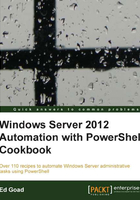
Conventions
In this book, you will find a number of styles of text that distinguish between different kinds of information. Here are some examples of these styles, and an explanation of their meaning.
Code words in text are shown as follows: "The installer is a fairly simple class, similar to the cmdlet class, which inherits the PSSnapin class and contains overrides that return information about the cmdlet."
A block of code is set as follows:
Function Multiply-Numbers
{
Param($FirstNum, $SecNum)
Try
{
Write-Host ($FirstNum * $SecNum)
}
Catch
{
Write-Host "Error in function, present two numbers to multiply"
}
}
When we wish to draw your attention to a particular part of a code block, the relevant lines or items are set in bold:
Write-Host "Static Size:`t`t" ("{0:0000000000.00}" -f $jenny)
Write-Host "Literal String:`t`t" ("{0:000' Hello '000}" -f $jenny)
Write-Host "Phone Number:`t`t" ("{0:# (###) ### - ####}" -f ($jenny*10000))
Any command-line input or output is written as follows:
Block-SmbShareAccess -Name Share2 -AccountName CORP\joe.smith ` -Confirm:$false
New terms and important words are shown in bold. Words that you see on the screen, in menus or dialog boxes for example, appear in the text like this: "clicking the Next button moves you to the next screen".